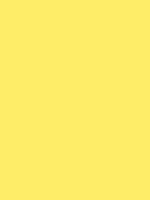#feed68 Color Information
In a RGB color space, hex #feed68 is composed of 99.6% red, 92.9% green and 40.8% blue. Whereas in a CMYK color space, it is composed of 0% cyan, 6.7% magenta, 59.1% yellow and 0.4% black. It has a hue angle of 53.2 degrees, a saturation of 98.7% and a lightness of 70.2%. #feed68 color hex could be obtained by blending #ffffd0 with #fddb00. Closest websafe color is: #ffff66.
-
- R 100
- G 93
- B 41
-
- C 0
- M 7
- Y 59
- K 0
● #feed68 color description : Soft yellow.
#feed68 Color Conversion
The hexadecimal color #feed68 has RGB values of R:254, G:237, B:104 and CMYK values of C:0, M:0.07, Y:0.59, K:0. Its decimal value is 16706920.
| Hex triplet | feed68 | #feed68 |
|---|---|---|
| RGB Decimal | 254, 237, 104 | rgb(254,237,104) |
| RGB Percent | 99.6, 92.9, 40.8 | rgb(99.6%,92.9%,40.8%) |
| CMYK | 0, 7, 59, 0 | |
| HSL | 53.2°, 98.7, 70.2 | hsl(53.2,98.7%,70.2%) |
| HSV (or HSB) | 53.2°, 59.1, 99.6 | |
| Web Safe | ffff66 | #ffff66 |
| CIE-LAB | 92.857, -9.949, 64.943 |
|---|---|
| XYZ | 73.656, 82.64, 25.167 |
| xyY | 0.406, 0.455, 82.64 |
| CIE-LCH | 92.857, 65.701, 98.71 |
| CIE-LUV | 92.857, 17.272, 81.146 |
| Hunter-Lab | 90.907, -14.46, 47.22 |
| Binary | 11111110, 11101101, 01101000 |
Color Schemes with #feed68
Alternatives to #feed68
Below, you can see some colors close to #feed68. Having a set of related colors can be useful if you need an inspirational alternative to your original color choice.
#feed68 Preview
This text has a font color of #feed68.
<span style="color:#feed68;">Text here</span>This paragraph has a background color of #feed68.
<p style="background-color:#feed68;">Content here</p>This element has a border color of #feed68.
<div style="border:1px solid #feed68;">Content here</div>.text {color:#feed68;}.background {background-color:#feed68;}.border {border:1px solid #feed68;}Shades and Tints of #feed68
A shade is achieved by adding black to any pure hue, while a tint is created by mixing white to any pure color. In this example, #050400 is the darkest color, while #fffdf0 is the lightest one.
-
#050400
#050400rgb(5,4,0) -
#181600
#181600rgb(24,22,0) -
#2c2700
#2c2700rgb(44,39,0) -
#3f3800
#3f3800rgb(63,56,0) -
#534a01
#534a01rgb(83,74,1) -
#665b01
#665b01rgb(102,91,1) -
#7a6c01
#7a6c01rgb(122,108,1) -
#8d7d01
#8d7d01rgb(141,125,1) -
#a18f01
#a18f01rgb(161,143,1) -
#b4a001
#b4a001rgb(180,160,1) -
#c8b101
#c8b101rgb(200,177,1) -
#dbc301
#dbc301rgb(219,195,1) -
#efd402
#efd402rgb(239,212,2)
-
#fde107
#fde107rgb(253,225,7) -
#fde41a
#fde41argb(253,228,26) -
#fee62e
#fee62ergb(254,230,46) -
#fee841
#fee841rgb(254,232,65) -
#feeb55
#feeb55rgb(254,235,85) -
#feed68
#feed68rgb(254,237,104) -
#feef7b
#feef7brgb(254,239,123) -
#fef28f
#fef28frgb(254,242,143) -
#fef4a2
#fef4a2rgb(254,244,162) -
#fff6b6
#fff6b6rgb(255,246,182) -
#fff9c9
#fff9c9rgb(255,249,201) -
#fffbdd
#fffbddrgb(255,251,221) -
#fffdf0
#fffdf0rgb(255,253,240)
Tones of #feed68
A tone is produced by adding gray to any pure hue. In this case, #b8b7ae is the less saturated color, while #feed68 is the most saturated one.
-
#b8b7ae
#b8b7aergb(184,183,174) -
#bebba8
#bebba8rgb(190,187,168) -
#c4c0a2
#c4c0a2rgb(196,192,162) -
#c9c49d
#c9c49drgb(201,196,157) -
#cfc997
#cfc997rgb(207,201,151) -
#d5cd91
#d5cd91rgb(213,205,145) -
#dbd28b
#dbd28brgb(219,210,139) -
#e1d685
#e1d685rgb(225,214,133) -
#e7db7f
#e7db7frgb(231,219,127) -
#ecdf7a
#ecdf7argb(236,223,122) -
#f2e474
#f2e474rgb(242,228,116) -
#f8e86e
#f8e86ergb(248,232,110) -
#feed68
#feed68rgb(254,237,104)
Color Blindness Simulator
Below, you can see how #feed68 is perceived by people affected by a color vision deficiency. This can be useful if you need to ensure your color combinations are accessible to color-blind users.
